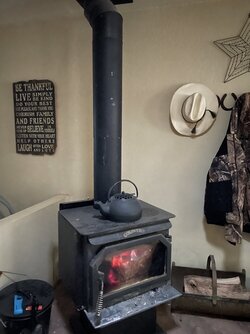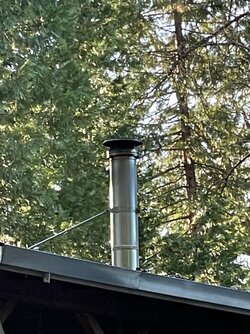So currently have a Country Striker S160. Been heating my house with it for about 10 years. I live up in the mountain in Northern California, house is about 1600 sf ft, single story on slab, has "ok" insulation, but 2x4 wall so runnign r13 insulation.
Temps in the middle of winter average daytime high's in the upper 40's to lower 50's, with night time lows in the high 20's to low 30's. During the day I normally have the stove half choked, running wide open in the early morning and night to keep the house around 70 degrees. Before bed I load up the stove with oak and choke it down all the way, typically the house will be about 66 when I wake up, and there will be a few embers so in the morning I can get it going pretty easily. Rinse and repeat the next day. Normally, unless I leave for the weekend the stove is going 24/7.
Occassionally we will get a couple weeks that get a bit colder (teens at night and hovering just above freezing during the day). During these time the stove is pretty much wide open and Im feeding wood as fast as I can, typically loading the firebox every 3-4 hours. At night whn the temps really drop I choke halfway, and wake up haldway through the night to load the box up again, typically in the morning the house will be in the lower 60's, takes a while to get it back up to temp...
Shoulder season typically is 70'ish during the day, upper 30's at night. During these days I have to fully choke the stove when the house is around 68 if I want to keep it going all day and not re-light a fire in the evening. Before bed throw 1-2 med size piece of oak in and choke all the way so I have embers in the morning. (this is the lazy method). The most effective method is let the house cool off to around 67, 1.5 hours before bed light a fire, get the stove warm, load it up with oak, choke it. These days the house is upper 60's when I wake up, normally throw a piece of wood in, open it up and let it burn itself out.
This has been fine for about the past 10 years, the house temps fluctuate a fair amount, but has never really bothered me. I now have a newborn at home, and we want to keep the house a more stable 70 degrees, and not have to pay as much attention to the wood stove.
I have been looking at a few options:
Option 1:
Upgrading to a bigger model of my current stove (Performer S210), familiarity would be the driver behind this, though not sure if they are still the same quality that my old Striker S160 (manufacturer date of 1997) is
Option 2:
Upgrade to another well recognized stove, bigger firebox, non-cat. Looking at a Lopi Evergreen... Bigger firebox, longer advertised burn times, more BTU...
Option 3:
Go against everything in my body telling me not to get a catalyst stove and get a catalyst stove. Looking at the BK Sirocco 30.2. Have been reading some threads on here about them, everyone seems to rave about them. Seems like a hige firebox (almost dbl what I currently have), so a little concerned I will cook myself out. From what I have gathered I would be able to keep a more stable temp, curious is this stove would be too much during my shoulder season and I would be letting it burn out and re-lighting, or if it could keep the temp stable enough when its turned down... Also need to do some research on hwo long the catalyst last and what a replacement timeline looks like. Im sure how long the catalyst lasts is different, I typically burn well seasoned wood (oak) and only softwoods I really burn is cedar just to get the oak going. Not sure if the lower temp longer burns would take its toll on the catalyst though...
Any thoughts or advice? Federal incentive (26%), and my local county also has a incentive of $500 so now seems like a good time to buy....
Temps in the middle of winter average daytime high's in the upper 40's to lower 50's, with night time lows in the high 20's to low 30's. During the day I normally have the stove half choked, running wide open in the early morning and night to keep the house around 70 degrees. Before bed I load up the stove with oak and choke it down all the way, typically the house will be about 66 when I wake up, and there will be a few embers so in the morning I can get it going pretty easily. Rinse and repeat the next day. Normally, unless I leave for the weekend the stove is going 24/7.
Occassionally we will get a couple weeks that get a bit colder (teens at night and hovering just above freezing during the day). During these time the stove is pretty much wide open and Im feeding wood as fast as I can, typically loading the firebox every 3-4 hours. At night whn the temps really drop I choke halfway, and wake up haldway through the night to load the box up again, typically in the morning the house will be in the lower 60's, takes a while to get it back up to temp...
Shoulder season typically is 70'ish during the day, upper 30's at night. During these days I have to fully choke the stove when the house is around 68 if I want to keep it going all day and not re-light a fire in the evening. Before bed throw 1-2 med size piece of oak in and choke all the way so I have embers in the morning. (this is the lazy method). The most effective method is let the house cool off to around 67, 1.5 hours before bed light a fire, get the stove warm, load it up with oak, choke it. These days the house is upper 60's when I wake up, normally throw a piece of wood in, open it up and let it burn itself out.
This has been fine for about the past 10 years, the house temps fluctuate a fair amount, but has never really bothered me. I now have a newborn at home, and we want to keep the house a more stable 70 degrees, and not have to pay as much attention to the wood stove.
I have been looking at a few options:
Option 1:
Upgrading to a bigger model of my current stove (Performer S210), familiarity would be the driver behind this, though not sure if they are still the same quality that my old Striker S160 (manufacturer date of 1997) is
Option 2:
Upgrade to another well recognized stove, bigger firebox, non-cat. Looking at a Lopi Evergreen... Bigger firebox, longer advertised burn times, more BTU...
Option 3:
Go against everything in my body telling me not to get a catalyst stove and get a catalyst stove. Looking at the BK Sirocco 30.2. Have been reading some threads on here about them, everyone seems to rave about them. Seems like a hige firebox (almost dbl what I currently have), so a little concerned I will cook myself out. From what I have gathered I would be able to keep a more stable temp, curious is this stove would be too much during my shoulder season and I would be letting it burn out and re-lighting, or if it could keep the temp stable enough when its turned down... Also need to do some research on hwo long the catalyst last and what a replacement timeline looks like. Im sure how long the catalyst lasts is different, I typically burn well seasoned wood (oak) and only softwoods I really burn is cedar just to get the oak going. Not sure if the lower temp longer burns would take its toll on the catalyst though...
Any thoughts or advice? Federal incentive (26%), and my local county also has a incentive of $500 so now seems like a good time to buy....




